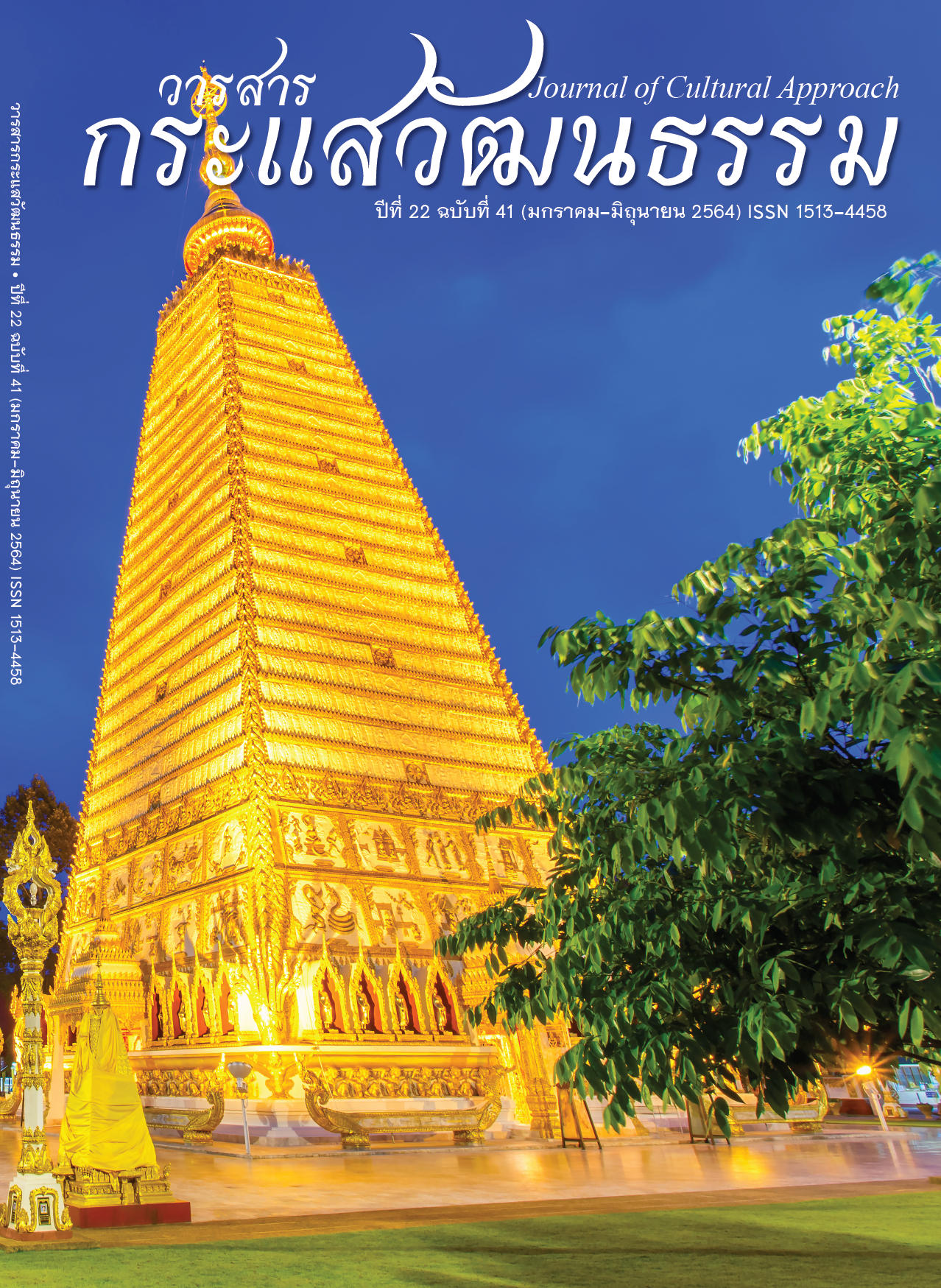กิจกรรมการตลาดในพระอารามหลวงที่มีผลต่อความตั้งใจทำบุญซ้ำของนักท่องเที่ยวเจนเนอเรชั่นวายชาวไทย
Main Article Content
บทคัดย่อ
การวิจัยครั้งนี้มีวัตถุประสงค์เพื่อศึกษา 1) ลักษณะพื้นฐานนักท่องเที่ยวเจนเนอเรชั่นวายชาวไทย และ2) ระดับความคิดเห็นกิจกรรมทางการตลาดในพระอารามหลวงที่มีผลต่อความตั้งใจทำบุญซ้ำของนักท่องเที่ยวเจนเนอเรชั่นวายชาวไทย โดยเก็บข้อมูลจากกลุ่มตัวอย่างนักท่องเที่ยวเจนเนอเรชั่นวายชาวไทยที่ไปเที่ยววัดไร่ขิง จำนวน 400 คน ซึ่งเป็นการวิจัยแบบผสมผสานโดยใช้การสัมภาษณ์และใช้แบบสอบถามเป็นเครื่องมือในการเก็บข้อมูล วิเคราะห์ข้อมูลด้วยสถิติที่ การแจกแจงความถี่ ค่าร้อยละ ค่าเฉลี่ยเลขคณิต ค่าส่วนเบี่ยงเบนมาตรฐาน
ตัวอย่างนักท่องเที่ยวเจนเนอเรชั่นวายชาวไทยโดยส่วนใหญ่เป็นเพศหญิงมีอายุ 21 - 25 ปี อยู่ในสถานภาพโสด มีการศึกษาระดับต่ำกว่าปริญญาตรี โดยประกอบอาชีพเป็นพนักงานบริษัทเอกชน ซึ่งมีรายได้เฉลี่ยต่อเดือนน้อยกว่าหรือเท่ากับ 15,000 บาท อาศัยอยู่ในภาคกลาง สาเหตุที่มาเที่ยววัดเพราะตั้งใจร่วมกิจกรรมกับทางวัด วัดที่กำลังเที่ยวรู้จักจากเพื่อน/คนรู้จัก รูปแบบการเดินทางท่องเที่ยวด้วยตนเอง และจำนวนครั้งและประสบการณ์ที่เดินทางมาเที่ยวมากกว่า 3 ครั้ง
ผลการศึกษาพบว่า โดยรวมกลุ่มตัวอย่างนักท่องเที่ยวเจนเนอเรชั่นวายชาวไทยมีความคิดเห็นต่อกิจกรรมการตลาดในพระอารามหลวงอยู่ในระดับกลาง (= 3.16) โดยเห็นด้วยมากเกี่ยวกับกิจกรรมการเป็นที่พึ่งทางใจ (
= 3.65) ส่วนความตั้งใจเที่ยวซ้ำของนักท่องเที่ยวเจนเนอเรชั่นวายชาวไทยอยู่ในระดับมาก (
=3.80) ด้านที่สำคัญคือ การบอกต่อ (
= 3.87)
Article Details

อนุญาตภายใต้เงื่อนไข Creative Commons Attribution-NonCommercial-NoDerivatives 4.0 International License.
Proposed Creative Commons Copyright Notices
1. Proposed Policy for Journals That Offer Open Access
Authors who publish with this journal agree to the following terms:
- Authors retain copyright and grant the journal right of first publication with the work simultaneously licensed under a Creative Commons Attribution License that allows others to share the work with an acknowledgement of the work's authorship and initial publication in this journal.
- Authors are able to enter into separate, additional contractual arrangements for the non-exclusive distribution of the journal's published version of the work (e.g., post it to an institutional repository or publish it in a book), with an acknowledgement of its initial publication in this journal.
- Authors are permitted and encouraged to post their work online (e.g., in institutional repositories or on their website) prior to and during the submission process, as it can lead to productive exchanges, as well as earlier and greater citation of published work (See The Effect of Open Access).
Proposed Policy for Journals That Offer Delayed Open Access
Authors who publish with this journal agree to the following terms:
- Authors retain copyright and grant the journal right of first publication, with the work [SPECIFY PERIOD OF TIME] after publication simultaneously licensed under a Creative Commons Attribution License that allows others to share the work with an acknowledgement of the work's authorship and initial publication in this journal.
- Authors are able to enter into separate, additional contractual arrangements for the non-exclusive distribution of the journal's published version of the work (e.g., post it to an institutional repository or publish it in a book), with an acknowledgement of its initial publication in this journal.
- Authors are permitted and encouraged to post their work online (e.g., in institutional repositories or on their website) prior to and during the submission process, as it can lead to productive exchanges, as well as earlier and greater citation of published work (See The Effect of Open Access).
เอกสารอ้างอิง
Aree Naipinit, Tirasaya Maneenetr, Thongphon Promsaka Na Sakolnakorn & Patarapong Kroeksakul. (2013). The Study Potentiality Approaches in Religion Tourism of “Roi Kaen Sarn Sin” Cluster Provinces. Panyapiwat Journal, 5(1), 31–40.
Banki, B. M., Ismail, H. N., Dalil, M. & Kawu, A. (2014). Moderating Role of Affective Destination Image on the Relationship between Tourists Satisfaction and Behavioral Intention: Evidence from Obudu Mountain Resort. Journal of Environment and Earth Sciences, 4(4), 47–60.
Bigne, J., Sanchez, I. & Andreu, L. (2009). The Role of Variety Seeking in Short and Long Run Revisit Intentions in Holiday Destinations. International Journal of Culture, Tourism and Hospitality Research, 3(2), 103–115.
Chen, C. F. & Tsai, D. (2007). How Destination Image and Evaluative Factors Affect Behavioral Intentions. Tourism Management, 28, 1115–1122.
Chi, G. C. & Qu, H. (2007). Examining the Structural Relationships of Destination Image, Tourist Satisfaction, and Destination Loyalty: An Integrated Approach. Tourism Management, 29, 624–636.
Cronin, J. J., Brady, M. K. & Hult, G. T. M. (2000). Assessing the Effects of Quality, Value, and Customer Satisfaction on Consumer Behavioral Intentions in Service Environments. Journal of Retailing, 76(2), 193–218.
Department of Provincial Administration. (2017). Statistical System of Registration. Retrieved December 15, 2018, from http://stat.dopa.go.th/stat/statnew/upstat_age_disp.php
Kanokwan Dungsrikaew. (1999). The Development of Temples as the Tourist Sites. TAT Review, 18(4), 48–52.
Kotler, P. (2003). Marketing Management. Englewood Cliffs: Prentice–Hall.
Kuo, C. (2011). Tourist Satisfaction and Intention to Revisit Sun Moon Lake. Journal of International Management, 6(2), 1–6.
Nattapong Sribunrueng, Suvimol Manjing & Paradai Chainuwat. (2009). Alternative: Psycho–Social Correlation of Buddhist Tourism Behavior. Rajamangala University of Technology Thanyaburi.
Oppermann, M. (2000). Tourism Destinations Loyalty. Journal of Travel Research, 39(11), 78–84.
Phra Somphop Nasing, Chamnan Rodhetbhai & Ying Kirtiburana. (2013). Royal Buddhist Monasteries in Rattanakosin Period: Potential Development Guidelines for Promoting Cultural Tourism. International Journal of Academic Research in Business and Social Sciences, 3(9), 671–676.
Phramaha Bunphichet Chanmueang. (2010). Tourism Management of the Royal Temples on the Rattanakosin Island. Master’s Thesis, Department of Planning and Management Ecotourism, Faculty of Science, Srinakharinwirot University.
Phramaha Chan Chotiyanphol. (2015). The Thai Temple Identity in Buddhism Affecting Repeat Foreign Tourists. Ph.D. Thesis, Department of Marketing, Faculty of Business Administration, Siam University.
Phramaha Suriya Masanthia. (2015). Value Enrichment Strategy for Buddhism–Based Tourism Marketing in Royal Monasteries around Rattanakosin Island. Ph.D. Thesis, Department of Marketing, Faculty of Business Administration, Siam University.
Pizam, A. & Mansfield, Y. (1999). Consumer Behavior in Travel and Tourism. New York: Haworth Press.
Pollack, B. L. (2009). Linking the Hierarchical Service Quality Model to Customer Satisfaction and Loyalty. Journal of Services Marketing, 23(1), 42–50.
Rasika Angkura. (2001). The Availability of Temples in Bangkok on the Propagation of Buddhism through Guided the Art and Culture. Sukhothai Thammathirat Open University.
Ratchada Asisonthisakul. (2005). Why Generation Y is Interesting. Productivity World, 10(59).
Saowakhon Withawatoran. (2007). Gen Y Hold It Tight and Squeeze It to Work. Bangkok: Bangkokbizbook.
SCB Economic Intelligence Center. (2014). A Bunch of Consumer Strategy of Gen Y. Retrieved December 15, 2019, from http://www.scbeic.com/th/detail/product/130130
Somkid Jirathasnakul. (2000). The Buddhist Temple with Thai Architecture. Silpakorn University.
Supaporn Varapol. (2003). Monasteries: Tourism Sites of Art. TAT Review, 22, 46–63.
Thammarat Yooprot. (2013). Effect of Work Values on Organizational Citizenship Behavior among the Generations. Thammasat Business Journal, 36(138), 40–62.
Tourism Authority of Thailand. (2000). The Monasteries Development 43. Bangkok.
Yamane, T. (1973). Statistics: An Introductory Analysis. 3rd ed. New York: Harper and Row.


